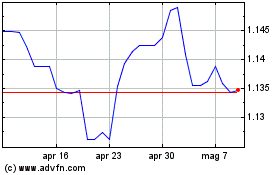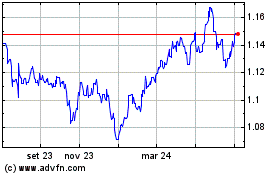Pound Falls On No-deal Brexit Fears
23 Dicembre 2019 - 9:25AM
RTTF2
The pound declined against its major counterparts in the
European session on Monday, as fears over a hard-Brexit intensified
after U.K. Parliament voted in favor of Boris Johnson's Brexit
Withdrawal Agreement last week.
The bill paves way for the U.K.'s departure from the bloc on
January 31 and remain in the single market and customs union until
December 31, 2020.
Johnson has set December 2020 as a hard deadline for a trade
deal to be reached with the EU, lifting odds of a no-deal exit.
The bill will now move to the House of Lords, where it is
expected to to passed with no hurdles.
European stocks were little changed after nearing a record high
in the previous session amid signs of progress on a phase-one deal
between the United States and China.
U.S. President Donald Trump on Saturday said the United States
and China would "very shortly" sign their so-called Phase One trade
pact.
The currency rose against its major counterparts in the previous
session.
The pound fell to a 3-week low of 0.8566 against the euro from
Friday's closing value of 0.8514. The pound is seen finding support
around the 0.88 level.
Data from Destatis showed that Germany's import prices declined
at a slower pace in November on weak energy prices.
On a yearly basis, import prices decreased by less-than-expected
2.1 percent, following a 3.5 percent fall in October. Prices were
expected to decline 2.3 percent.
The pound declined to 1.2928 against the greenback, its weakest
level since December 2. On the downside, 1.28 is likely seen as the
next support level for the pound.
The U.K. currency depreciated to near a 6-week low of 1.2683
against the franc from last week's closing quote of 1.2769. Next
possible support for the pound is seen around the 1.25 level.
The pound weakened to 141.26 against the yen for the first time
since December 4. The pound is likely to find support around the
137.00 level, if it drops further.
Data from the Ministry of Economy, Trade and Industry showed
that Japan's all industry activity dropped for the first time in
four months in October.
The all industry activity index fell 4.3 percent month-on-month
in October, after a 1.9 percent rise in September. This was the
first decrease since June and in line with economists'
expectations.
Looking ahead, Canada GDP data for October, U.S. durable goods
orders and new home sales for November are due out in the New York
session.
Grafico Cross Sterling vs CHF (FX:GBPCHF)
Da Mar 2024 a Apr 2024

Grafico Cross Sterling vs CHF (FX:GBPCHF)
Da Apr 2023 a Apr 2024
